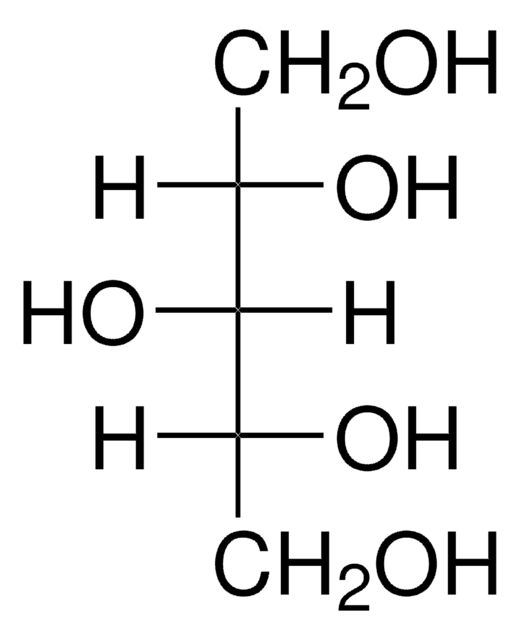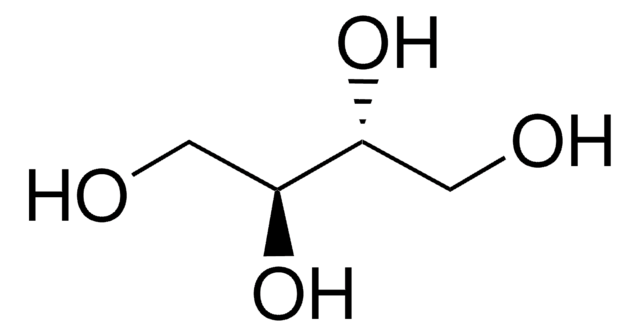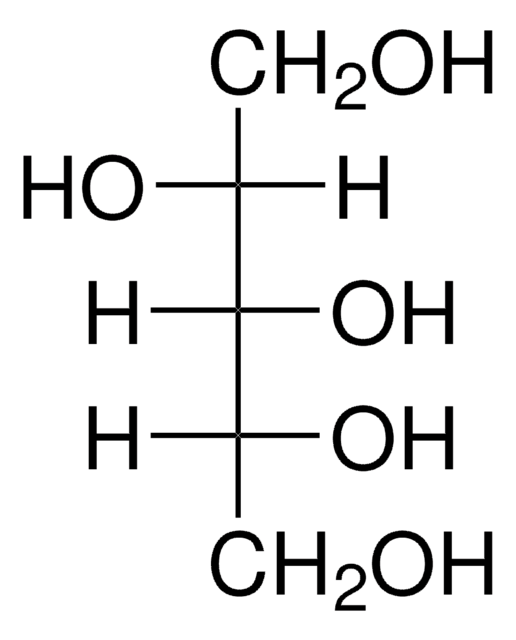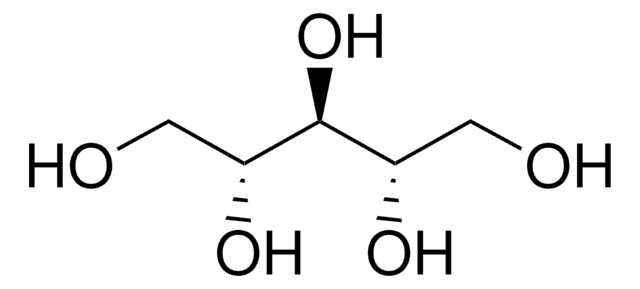All Photos(6)
About This Item
Linear Formula:
HOCH2[CH(OH)]3CH2OH
CAS Number:
Molecular Weight:
152.15
Beilstein:
1720523
EC Number:
MDL number:
UNSPSC Code:
12352201
PubChem Substance ID:
NACRES:
NA.25
Recommended Products
Quality Level
Assay
≥99% (GC)
form
crystalline
crystals or chunks
powder
sweetness
1 × sucrose
color
colorless
mp
94-97 °C (lit.)
solubility
water: 642g/l at 25 °C (77 °F )
SMILES string
OC[C@@H](O)[C@H](O)[C@@H](O)CO
InChI
1S/C5H12O5/c6-1-3(8)5(10)4(9)2-7/h3-10H,1-2H2/t3-,4+,5+
InChI key
HEBKCHPVOIAQTA-SCDXWVJYSA-N
Looking for similar products? Visit Product Comparison Guide
General description
Xylitol is a naturally occurring five carbon sugar alcohol, equivalent to sucrose in sweetness. Xylitol finds applications in the preparation of confectionaries, chewing gum, toothpaste and mouthwashes. Xylitol is a low-energy sweetener with insulin independent metabolism, making it a promising alternative for sugar in diabetic patients. Xylitol is a natural anticaries agent used in the treatment of dental caries, as it is not utilized by cariogenic bacteria creates a starvation effect on them. Xylitol prevents otitis and upper respiratory tract infections. Commercially, microorganisms like bacteria, fungi and yeasts produce xylitol by fermentation.
Application
Xylitol has been used:
- as a standard for high performance liquid chromatography
- in analysing antibacterial activity on oral biofilms
- for thermodynamic data and densities measurement
Biochem/physiol Actions
A sugar alcohol sweetener detectable by humans. Produced from hemicellulose hydrolysate fermentation.
Other Notes
To gain a comprehensive understanding of our extensive range of sugar alcohols for your research, we encourage you to visit our Carbohydrates Category page.
Storage Class Code
11 - Combustible Solids
WGK
WGK 3
Flash Point(F)
Not applicable
Flash Point(C)
Not applicable
Personal Protective Equipment
dust mask type N95 (US), Eyeshields, Gloves
Choose from one of the most recent versions:
Already Own This Product?
Find documentation for the products that you have recently purchased in the Document Library.
Customers Also Viewed
Synergistic effect of xylitol and ursolic acid combination on oral biofilms
Zou Y, et al.
Restorative dentistry & endodontics, 39(4), 288-295 (2014)
Molecular strategies for enhancing microbial production of xylitol
Pal S, et al.
Process Biochemistry (Oxford, United Kingdom), 51(7), 809-819 (2016)
Culture parameters affecting xylitol production by Debaryomyces hansenii immobilized in alginate beads
Perez-Bibbins B, et al.
Process Biochemistry (Oxford, United Kingdom), 48(3), 387-397 (2013)
Apparent molar volumes and apparent molar heat capacities of aqueous adonitol, dulcitol, glycerol, meso-erythritol, myo-inositol, D-sorbitol, and xylitol at temperatures from (278.15 to 368.15) K and at the pressure 0.35 MPa
Blodgett MB, et al.
The Journal of Chemical Thermodynamics, 39(4), 627-644 (2007)
Mette K Keller et al.
BMC oral health, 12, 44-44 (2012-10-25)
The increasing interest in probiotic lactobacilli in health maintenance has raised the question of potential risks. One possible side effect could be an increased acidogenicity in dental plaque. The aim of this study was to investigate the effect of probiotic
Our team of scientists has experience in all areas of research including Life Science, Material Science, Chemical Synthesis, Chromatography, Analytical and many others.
Contact Technical Service






